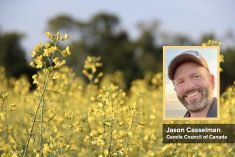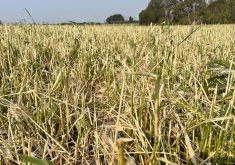Blackleg is on the uptick in Saskatchewan. The disease survey went 10 years with blackleg bumping along the bottom of the graph at low levels. But then prevalence — the percentage of fields with some level of blackleg infestation — rose from the 10-year average of 25 per cent up to 54 per cent in 2014 and 57 per cent in 2015.
Prevalence had been that high before. In 2003, 53 per cent of surveyed Saskatchewan canola fields had blackleg. What has changed this time is the incidence rate. Incidence is the percentage of plants showing blackleg symptoms within those infested fields. Incidence in 2003 was very low — 0.1 per cent. It stayed at 1.0 per cent or below until 2010, when it went to 2.9 per cent. Then in 2014 it took another leap, to 7.0 per cent, and reached 9.0 per cent in 2015.
Read Also

Could crop sharing be a viable option for your farm?
Crop sharing could be a good option for young and beginning farmers.
Faye Dokken-Bouchard, provincial plant disease specialist with the Saskatchewan Ministry of Agriculture, notes that these results are preliminary. “We haven’t gone through them with a fine-tooth comb as we usually do for the final report in the Canadian Plant Disease Survey,” she says. “But whether these blackleg-like symptoms are confirmed as blackleg or something else is causing blackening of the stem bases, there is likely to be somewhat of an impact on the crops as a result, as necrotic tissue in the stem will prevent water and nutrients from being taken up by the plant, resulting in yield loss.”
The general rule for estimating yield loss is to divide incidence by two. With an average incidence of nine per cent in Saskatchewan in 2015, these stem lesions are causing potential yield loss of 4.5 per cent.

When asked why 2015, a generally drier year, saw continued increase in the disease, Dokken-Bouchard says, “This is likely a result of a buildup of the pathogen in the past few wet years, shorter rotations and/or incompatibility between the blackleg races present and the resistance in the canola varieties being used.”
She adds that hail may have been a factor as well. “This disease is often associated with hail damage, so even without a lot of rain the pathogen may have been introduced via hailstorms and hail damage.”
Saskatchewan blackleg numbers are still lower than Manitoba, which had a prevalence of 93 per cent and incidence of 24 per cent in 2014 and prevalence of 80 per cent and incidence of 14 per cent in 2015. Blackleg prevalence in Alberta in 2015 was 64 per cent with an incidence of nine per cent.

For 2016, Dokken-Bouchard recommends that growers learn to identify canola diseases and scout for symptoms starting at the seedling stage to determine if blackleg (and other diseases) are a problem. “If they are getting worse within the season and over the years, growers can prevent blackleg by growing non-host crops in a four-year rotation between canola crops,” she says.
Clubroot in Manitoba
While no canola plants collected from the 152 canola crops surveyed in Manitoba in 2015 showed visual symptoms of clubroot, the Plant Surveillance Initiative Lab in Winnipeg has found DNA from P. brassicae in soil all over the province. And while galls are still few and far between, clubroot symptoms (dying plants and galls on roots) were confirmed in the Swan River Valley and in the RM of Pembina in 2015.
In the Swan River case, a grower noticed a dead patch in his canola field and called his agronomist. The agronomist found the galls.
Soil samples have been sent away to determine spore concentration. Anastasia Kubinec, oilseed crops specialist with Manitoba Agriculture, Food and Rural Development, and the Swan River agronomist want to figure out the clubroot pathotypes to give producers an idea of what clubroot-resistant varieties to choose.
Using seed with genetic resistance to clubroot is by far the most important tool to manage the disease. Protecting that resistance, therefore, is a valuable endeavour.
Ralph Lange, speaking at Canola Discovery Forum in Canmore, Alta. in October, described the five phases of disease management.
- Phase 1: The invaders show up. Blackleg, clubroot and Verticillium longisporum, he notes, are all invasive species.
- Phase 2: Disease management specialists provide practices to limit spread of the pathogen. These often include machinery sanitation and rotation away from host crops.
- Phase 3: Breeders introduce resistance genes in commercial lines.
- Phase 4: Pathogens adapt, and resistance breaks down. The rate that this happens at depends on factors like the biology and genetics of the pathogen, how frequently in time and space the host crop is grown, and how the pathogen is dispersed. For clubroot, this can happen very quickly. For fusarium wilt or verticillium wilt, it can be very slow.
- Phase 5: New resistant genes are found and introduced.
“Phases 4 and 5 repeat, getting steadily more intense with each round, until the crop can no longer be produced economically based on lower yield potential and higher input and management costs,” Lange says.
This is already happening with clubroot resistance, as fields in central Alberta that have been seeded to R varieties a couple of times are already showing signs of pathogen shift.
Stephen Strelkov with the University of Alberta tested soil samples from 27 fields in Alberta that were seeded to resistant varieties in 2014 and showed more-than-expected levels of gall formation. Of those 27 fields, 16 have unknown “class x” clubroot pathotypes that suggest the clubroot population in those fields had shifted to overcome the resistance trait in the variety grown. Surveys in 2015 expanded the number and range of these virulent pathotypes, which will be labelled in the near future.
The way to protect the resistance trait and extend Phase 3 is to combine the management steps in Phases 2 and 3. Cleaning the soil from equipment before it leaves a clubroot-infested field will reduce the speed of spread through a farm. Rotation, even one year in three for canola, will greatly reduce the population of resting spores compared to two-year rotations and back-to-back canola. This break also buys genetic specialists and seed companies time to adapt to each Phase 4 with new advancements for Phase 5.
“We’re in an era of managing resistance genes and not just the disease itself,” Lange says.
Jay Whetter is communications manager for the Canola Council of Canada.
How to protect clubroot R traits
Pathogens will adapt to repeated use of the same resistance trait. The following steps used together will reduce disease spread, reduce infection levels and reduce selection pressure for virulent strains of a pathogen that can overcome genetic resistance (R) traits.
For communities known to have clubroot:
- Keep a close watch. Look for unexpected levels of clubroot in fields seeded to resistant varieties. This is a sign that pathotype shift has reduced the effectiveness of the resistance trait in your fields. — Sanitation. Few growers are taking time to disinfect (final misting with bleach, EcoClear, or HyperOx) equipment because of the time it takes. But growers in these higher-risk zones must at least knock the dirt off equipment before leaving fields. At least 90 per cent of clubroot spores that move from field to field can be stopped by scraping off dirt.
- Avoid tillage as it moves a lot of clubroot-infested soil around the field and from field to field.
- Control host weeds and canola volunteers that provide a bridge for clubroot galls and spore buildup even when canola is not produced on a field.
- Continue using resistant varieties and look for new genetics in the future. Never use susceptible varieties on clubroot-infested soil or in areas with a high prevalence of clubroot.
For communities without a case of clubroot:
- Scout vigilantly for signs of clubroot.
- Avoid the introduction of clubroot by cleaning and monitoring equipment entering fields.
- Use cleaned and treated seed only.
- Use resistant varieties when growers think they are at higher risk.
- Control volunteers and host weeds.
For more on clubroot management, go to canolawatch.org and read clubroot articles under the “Diseases” heading.















